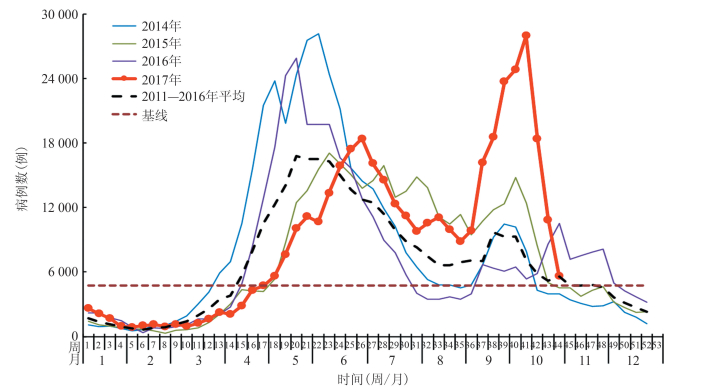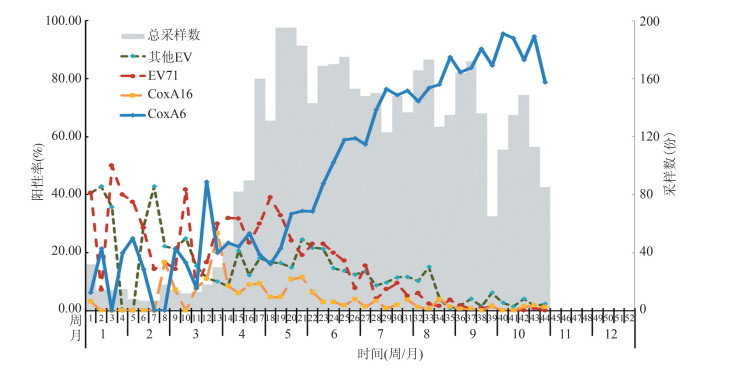扩展功能
文章信息
- 张萌, 龙遗芳, 杨芬, 曾汉日, 吴崧霖, 郭莉敏, 马学凤, 李晖, 孙立梅
- Zhang Meng, Long Yifang, Yang Fen, Zeng Hanri, Wu Songlin, Guo Limin, Ma Xuefeng, Li Hui, Sun Limei
- 2017年广东省秋季手足口病疫情高发流行特征及因素分析
- Characteristics of high incidence of hand foot and mouth disease and related factors in autumn of 2017 in Guangdong
- 疾病监测, 2018, 33(1): 37-41
- Disease Surveillance, 2018, 33(1): 37-41
- 10.3784/j.issn.1003-9961.2018.01.009
-
文章历史
- 收稿日期:2017-12-18
2. 广东省现场流行病学培训项目, 广东 广州 511430;
3. 深圳市坪山区疾病预防控制中心, 广东 深圳 518118;
4. 清远市清城区疾病预防控制中心, 广东 清远 511500;
5. 甘孜藏族自治州疾病预防控制中心, 四川 甘孜 626000
2. Guangdong Provincial Field Epidemiology Training Program, Guangzhou 511430, Guangdong, China;
3. Pingshan District Center for Disease Prevention and Control, Shenzhen 518118, Guangdong, China;
4. Qingchen District Center for Disease Control and Prevention, Qingyuan 511500, Guangdong, China;
5. Ganzi Autonomous Prefecture Center for Disease Control and Prevention, Kangding 626000, Sichuan, China
手足口病是由多种人肠道病毒引起的急性传染病,其中以肠道病毒71型(EV71)和柯萨奇病毒A组16型(Cox A16)感染最常见[1-3]。广东省手足口病的流行季节为每年3—10月,呈现两个发病高峰,主高峰在5—7月,次高峰在9—10月[2, 4-6]。2017年秋季(9—10月)广东省手足口病发病水平大幅增加,周发病数峰值较2017年夏季高峰升高34.72%,较2011—2016年同期平均水平升高167.71%。本研究重点探讨分析2017年广东省手足口病秋季疫情高发原因,为疫情防控提供参考依据。
1 资料与方法 1.1 资料来源病例监测数据来自“中国疾病预防控制信息系统”中“传染病报告信息系统”2011年1月1日至10月30日广东省各级医疗机构报告的手足口病个案数据;病例诊断参照《手足口病诊疗指南(2010年版)》[7]。暴发疫情信息来自同时期“中国疾病预防控制信息系统”中广东省21个地市级及121个县(区)级疾病预防控制中心(CDC)通过“突发公共卫生事件管理信息系统”报告的手足口病事件信息,报告标准:一周内,同一托幼机构或学校等集体单位发生≥10例手足口病病例;或同一个自然村/居委会发生≥5例手足口病病例[8]。2013—2017年广东省人口学信息来自“中国疾病预防控制系统”中“基本信息系统”。
1.2 病原学监测数据2017年开始,广东省在21个地市及佛山市顺德区各选取1家医疗机构作为手足口病监测哨点。每家哨点医院在手足口病流行期间(4—11月)每周至少采集8份普通病例的粪便或肛拭子标本,非流行期间(1—3月,12月)每周至少采集3份普通病例的粪便标本。采用实时反转录聚合酶链反应(real time reverse transcription polymerase chain reaction,real time RT-PCR)或反转录聚合酶链反应(reverse transcription polymerase chain reaction,RT-PCR)技术对监测样本进行肠道病毒(肠道病毒通用型、EV71、Cox A16、Cox A6)核酸检测。选取2015—2017年Cox A6核酸阳性标本进行VP1全长序列扩增,扩增引物序列参考从GenBank下载的Cox A6基因组全长序列,采用Primer Premier 5.0软件设计获得。采用ABI 3100型全自动遗传分析仪进行测序分析。采用DNAStar 6.0软件对双向测序结果进行拼接与整理,并对2015—2017年的Cox A6病毒VP1全长序列进行同源性比对分析。
1.3 统计学分析采用Excel软件进行数据录入,使用SPSS 22.0软件进行统计学分析。采用描述性流行病学方法进行分析,计数资料计算率和比例。
2 结果 2.1 疫情特点 2.1.1 疫情概述2017年9月1日至10月31日,广东省报告手足口病152 791例;与2011—2016年同期平均水平相比(65 506例),报告发病数增加133.25%;与2017年夏季流行高峰期(6月1日至7月31日,124 060例)相比,报告发病数增加23.16%。
2.1.2 时间分布广东省2017年夏季流行高峰发生在6—7月,流行期(6月1日至7月31日)峰值为18 425例/周,与2011—2016年同期平均峰值水平接近,低于2016年水平(25 875例/周)。秋季发病高峰发生在9—10月,流行期(9月1日至10月31日)峰值(24 822例/周)较2017年夏季高峰峰值(18 425例)升高34.72%,较2011—2016年同期平均水平(9 272例)升高167.71%,见图 1。

|
| 图 1 2014—2017年广东省手足口病病例发病时间分布 Figure 1 Time distribution of HFMD cases in Guangdong, 2014-2017 |
| |
2017年秋季发病高峰(9月1日至10月30日)期间,发病强度(按周均发病率计算)以深圳、珠海、中山、云浮、广州、惠州、广州市最高,与夏季发病高峰(6月1日至7月31)地区分布不同。2017年秋季较夏季发病强度增加, 以秋、夏季周均发病率增长率计算,结果除湛江外,20个地市均有不同程度增加,其中云浮、茂名等9个地市增加幅度超过100%,见表 1。
| 地市 | 夏季周均(6月1日至7月31日) | 秋季周均(9月1日至10月30日) | 夏-秋周均发病率差(/10万) | 夏-秋周均发病率增长率(%) | |||
| 发病数 | 发病率(/10万) | 发病数 | 发病率(/10万) | ||||
| 云浮 | 510 | 20.75 | 2 154 | 87.60 | 66.84 | 322.11 | |
| 茂名 | 295 | 4.85 | 1 216 | 19.99 | 15.13 | 311.75 | |
| 梅州 | 527 | 12.15 | 2 020 | 46.55 | 34.40 | 283.15 | |
| 河源 | 522 | 16.98 | 1 711 | 55.66 | 38.68 | 227.79 | |
| 深圳 | 3 315 | 29.13 | 10 814 | 95.03 | 65.90 | 226.23 | |
| 中山 | 951 | 29.63 | 2 581 | 80.40 | 50.77 | 171.38 | |
| 惠州 | 1 714 | 36.04 | 4 330 | 91.02 | 54.98 | 152.56 | |
| 肇庆 | 1 247 | 30.71 | 2 717 | 66.91 | 36.20 | 117.89 | |
| 东莞 | 2 609 | 31.61 | 5 409 | 65.54 | 33.93 | 107.33 | |
| 阳江 | 403 | 16.05 | 737 | 29.33 | 13.28 | 82.71 | |
| 广州 | 5 726 | 42.41 | 10 381 | 76.88 | 34.47 | 81.28 | |
| 揭阳 | 318 | 5.26 | 549 | 9.08 | 3.81 | 72.49 | |
| 潮州 | 138 | 5.24 | 230 | 8.71 | 3.47 | 66.21 | |
| 江门 | 956 | 21.16 | 1 554 | 34.39 | 13.23 | 62.53 | |
| 佛山 | 3 371 | 45.36 | 5 037 | 67.77 | 22.41 | 49.40 | |
| 汕尾 | 215 | 7.11 | 273 | 9.04 | 1.93 | 27.13 | |
| 珠海 | 1 239 | 75.83 | 1 492 | 91.29 | 15.46 | 20.39 | |
| 汕头 | 639 | 11.52 | 730 | 13.15 | 1.64 | 14.21 | |
| 清远 | 1 367 | 35.65 | 1 441 | 37.59 | 1.94 | 5.43 | |
| 韶关 | 1 317 | 44.94 | 1 361 | 46.43 | 1.49 | 3.32 | |
| 湛江 | 696 | 9.62 | 531 | 7.33 | -2.28 | -23.76 | |
2013年以来,1岁组的周均发病率均为最高,4岁组开始周均发病率明显降低。2017年秋季发病高峰期间,各年龄组周均发病率均高于2013—2016年同期平均水平;与2017年夏季高峰期相比,4岁以下各年龄组周均发病率均有升高,4岁以上人群降低,见表 2;病例的职业构成均以散居儿童为主,未发生明显变化。
| 年龄组(岁) | 2017年9—10月 | 2017年6—7月 | 2016年9—10月 | 2015年9—10月 | 2014年9—10月 | 2013年9—10月 | |||||||||||
| 病例数 | 发病率(/10万) | 病例数 | 发病率(/10万) | 病例数 | 发病率(/10万) | 病例数 | 发病率(/10万) | 病例数 | 发病率(/10万) | 病例数 | 发病率(/10万) | ||||||
| 0~ | 3 714 | 281.27 | 2 464 | 186.56 | 628 | 52.35 | 984 | 78.75 | 896 | 72.46 | 1 659 | 141.23 | |||||
| 1~ | 7 905 | 493.23 | 5 414 | 337.80 | 1529 | 105.00 | 2206 | 152.05 | 2 106 | 146.75 | 3 276 | 240.41 | |||||
| 2~ | 4 245 | 264.62 | 3 084 | 192.20 | 884 | 60.65 | 1251 | 86.03 | 1 345 | 93.76 | 1 671 | 129.70 | |||||
| 3~ | 3 364 | 257.82 | 2 226 | 170.61 | 719 | 60.66 | 944 | 79.90 | 958 | 82.08 | 1 138 | 97.69 | |||||
| 4~ | 1 568 | 131.23 | 1 619 | 135.56 | 338 | 31.19 | 369 | 34.11 | 416 | 38.94 | 451 | 42.09 | |||||
| ≥5 | 1630 | 1.58 | 1840 | 1.79 | 319 | 0.31 | 592 | 0.59 | 413 | 0.41 | 562 | 0.56 | |||||
2017年1—5月,广东省手足口病病原体处于EV71、Cox A16、柯萨奇病毒A组6型(Cox A6)及其他肠道病毒(除EV71、Cox A16和Cox A6的其他肠道病毒)交替更迭阶段。6月开始,Cox A6逐步成为优势毒株,且阳性率呈直线上升趋势,9月开始Cox A6阳性率超过80%,见图 2。

|
| 图 2 2017年广东省手足口病哨点医院病原学监测结果 Figure 2 Etiological surveillance for HFMD in Sentinel hospitals in Guangdong, 2017 |
| |
对2015—2017年监测到的175份Cox A6核酸阳性标本进行VP1全长序列测序并进行同源性比对分析。2017年监测到的84份Cox A6病毒VP1核苷酸同源性为97.3% (93.9%~100.0%);与2016年监测到的27份Cox A6病毒相比,VP1核苷酸同源性为96.5%(94.1%~ 99.9%);与2015年监测到的64份Cox A6病毒相比,VP1核苷酸同源性为96.2%(91.4%~98.9%)。
3 讨论2017年秋季广东省手足口病出现异常的大幅增加,本研究分析发现,疫情高发因全省各地市发病水平普遍增长引起,与优势毒株转为Cox A6有关。
广东省2017年秋季手足口病周发病数峰值大幅超过2016年同期和2017年夏季高峰水平,为广东省2009年以来首次出现秋季发病峰值高于夏季的现象;同期,全国手足口病发病数虽较2016年同期上升,但未超过夏季高峰水平[9]。因此,广东省秋季高峰属于异常增加。有文献表明,Cox A6作为优势毒株流行时,流行区域的手足口病发病数会处于较高水平[10];对2015—2017年广东省手足口病病原学监测中的CoxA6病毒的VP1全长序列同源性分析发现,2017年的CoxA6流行株与2015年和2016年相比较核苷酸同源性存在差异,尤其与2015年病毒差异相对较大。以上数据提示Cox A6病毒随着时间的推移存在着不断进化的现象,病毒进化到一定阶段可能对其病毒毒力或传播能力产生影响,因此需要对这些变化展开深入地研究和分析。
广东省2016年8月开始使用EV71疫苗,现阶段EV71疫苗接种对EV71及其他手足口病相关病毒流行造成的影响仍需继续进行监测,以观察其长期影响。同时,2016年1月1日开始,全国开始启动二胎政策,该政策可能会增加手足口病易感人群的数量,但目前尚无足够的数据支持,有待进一步的监测和分析评估。
Cox A6感染病例年龄低于EV71和Cox A16感染病例。Cox A6感染病例中具有发热症状的比例明显多于EV71和Cox A16,同时,其所致皮疹具多样性,除典型皮疹出现的手、足、臀部位外,还较多出现在躯干,常表现为多种形态皮疹同时出现,以斑丘疹、疱疹并存最为常见,因此易被误诊为水痘,临床上需引起注意;病例多为自限性,死亡病例报道较少[11-12]。
本研究存在一定的局限性,广东省手足口病病例数据来源于“中国疾病预防控制信息系统”中医疗机构报告病例情况,并非全省实际发病情况,存在病例数低估的可能。手足口病诊断以临床诊断为主,不同地区和不同级别医疗机构对诊断标准的掌握不同,对病例报告存在一定的影响。Cox A6病毒VP1序列分析仅有2015—2017年3年的数据,其变化情况和可能造成的影响需开展更长时间的监测和研究。
基于本研究的分析结果和发现,建议:广东省各地市应加强疫情监测,及时掌握优势病毒株变化情况,严格开展各项疫情防控工作。各级医疗机构、社区卫生服务中心等要提高病例诊治意识和能力。针对5岁以下的幼托和散居儿童加强手足口病的防控。
作者贡献:
张萌 ORCID:0000-0001-5594-4066
张萌:数据收集和整理,数据分析,文章撰写
龙遗芳:数据收集和整理,数据分析
杨芬:数据分析
曾汉日:实验室检测和基因测序
吴崧霖、郭莉敏、马学凤:数据收集和整理
李晖:组织协调实验室检测和基因测序工
孙立梅:组织协调研究开展
| [1] |
Xing WJ, Liao QH, Viboud C, et al. Epidemiological characteristics of hand, foot and mouth disease in China, 2008-2012[J]. Lancet Infect Dis, 2014, 14(4): 308-318. DOI:10.1016/S1473-3099(13)70342-6 |
| [2] |
孙立梅, 邓爱萍, 康敏, 等. 2009—2010年广东省手足口病流行特征分析[J]. 华南预防医学, 2011, 37(4): 9-13. Sun LM, Deng AP, Kang M, et al. Epidemiological characteristics of hand, foot and mouth disease in Guangdong, 2009-2010[J]. South China J Prev Med, 2011, 37(4): 9-13. |
| [3] |
常昭瑞, 张静, 孙军玲, 等. 中国2008—2009年手足口病报告病例流行病学特征分析[J]. 中华流行病学杂志, 2011, 32(7): 676-680. Chang ZH, Zhang J, Sun JL, et al. Epidemiological features of hand, foot and mouth disease in China, 2008-2009[J]. Chin J Epidemiol, 2011, 32(7): 676-680. |
| [4] |
杜玉忠, 孙立梅, 康敏, 等. 广东省2010—2011年手足口病高峰期流行特征分析[J]. 中国热带医学, 2014, 14(2): 159-161. Du YZ, Sun LM, Kang M, et al. Epidemiological characteristics of HFMD in the peak period in Guangdong province from 2010 to 2011[J]. China Trop Med, 2014, 14(2): 159-161. |
| [5] |
王铁强, 邓爱萍, 帅惠萍, 等. 应用集中度与圆形分布法分析2009—2011年广东省手足口病季节性特征[J]. 华南预防医学, 2013, 39(3): 33-35. Wang TQ, Deng AP, Shuai HP, et al. Concentration degree analysis and circular distribution method for seasonal characters of hand, foot and mouth disease in Guangong, 2009-2011[J]. South China J Prev Med, 2013, 39(3): 33-35. |
| [6] |
冀天娇, 谭小华, 刘冷, 等. 广东省2008—2015年手足口病流行病学特征及病原学监测分析[J]. 病毒学报, 2016, 32(6): 713-720. Ji TJ, Tan XH, Liu L, et al. Epidemiology characteristics and pathogen surveillance of hand, foot and mouth disease in Guangdong province, China, 2008 -2015[J]. Chin J Virol, 2016, 32(6): 713-720. |
| [7] |
中华人民共和国卫生部. 手足口病诊疗指南(2010年版)[M]. 北京: 中华人民共和国卫生部, 2010. The Ministry of Health of the Peoplés Republic of China. Treatment guidelines(2010 edition)excerpt for hand, foot and mouth disease[M]. Beijing: The Ministry of Health of the People's Republic of China, 2010. |
| [8] |
中华人民共和国卫生部. 手足口病聚集性和暴发疫情处置工作规范(2012年版)[M]. 北京: 中华人民共和国卫生部, 2010. The Ministry of Health of the Peoplés Republic of China. Work specification(2012 edition)for clustering and outbreak of hand, foot and mouth disease[M]. Beijing: The Ministry of Health of the People's Republic of China, 2010. |
| [9] |
常昭瑞, 刘凤凤, 吕斌, 等. 2017年1—5月全国手足口病疫情形势分析[J]. 疾病监测, 2017, 32(6): 447-452. Chang ZR, Liu FF, Lyu B, et al. Analysis on surveillance data of hand, foot and mouth disease in China, January-May 2017[J]. Dis Surveill, 2017, 32(6): 447-452. DOI:10.3784/j.issn.1003-9961.2017.06.003 |
| [10] |
National Institute of Infectious Disease. Hand, foot and mouth disease and herpangina, 2007 to September 2017(week 38), Japan[Z]. Japan: National Institute of Infectious Disease, 2017.
|
| [11] |
屈晓婷. CA6阳性与EV71、CA16阳性手足口病患儿临床特征分析[J]. 中国妇幼健康研究, 2017, 28(10): 1226-1228. Qu XT. Clinical characteristics of children with CA6 positive, EV71 positive and CA16 positive hand, foot and mouth disease[J]. Chin J Woman Child Health Res, 2017, 28(10): 1226-1228. DOI:10.3969/j.issn.1673-5293.2017.10.021 |
| [12] |
刘国涛, 刘民. 柯萨奇病毒A组6型与肠道病毒71型感染所致手足口病临床特征比较[J]. 国际病毒学杂志, 2017, 24(2): 127-130. Liu GT, Liu M. Comparison of clinical features in hand, foot and mouth disease caused by coxsackievirus A6 and enterovirus 71[J]. Int J Virol, 2017, 24(2): 127-130. DOI:10.3760/cma.j.issn.1673-4092.2017.02.014.issn.1673-4092.2017.02.014 |
 2018, Vol. 33
2018, Vol. 33


